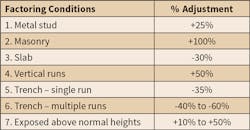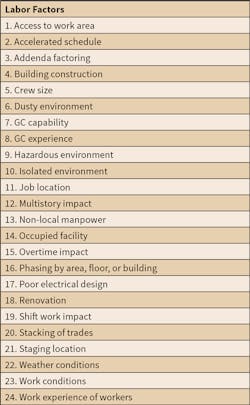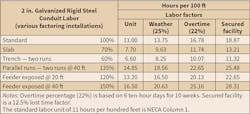An electrical estimator must estimate and account for all project costs, both direct and indirect. The process of estimating should answer these three basic questions:
1. How many?
2. How much?
3. How long?
The estimator must determine the quantity of each item required to complete the job, the cost of each item, and how many labor hours it will take to install each item. Depending on the type of project, sometimes determining the number of labor hours required can be the most difficult part of the process.
Construction is a risky business. When labor costs are a large percentage of a project’s value, estimating the labor costs accurately is vital. On projects where the equipment costs are a large percentage of a project, then the labor risk is minimized.
Understanding labor is one of the most important responsibilities of the estimator. There are three major components of labor. The estimator must understand all of these to arrive at an accurate labor cost summary for a project.
Labor columns
The NECA Manual of Labor Units applies labor per the following three conditions, each of which has a different percentage of installation labor for each item in your estimate.
NECA 1 (Normal Installation Conditions) — When all the conditions associated with the installation of an item will permit the maximum productivity of the electricians on a project, these “normal” column labor units are applicable.
NECA 2 (Difficult Installation Conditions) ― When one or more of the conditions associated with the installation of an item will permit less than maximum productivity of the electricians on a typical project, these “difficult” column labor units are applicable.
NECA 3 (Very Difficult Installation Conditions) ― When one or more of the conditions associated with the installation of an item will permit substantially less than maximum productivity of the electricians on a typical project, these “very difficult” column labor units are applicable.
Most leading brands of electrical estimating software allow the estimator to select the appropriate labor column for the project conditions. This is vital, as the labor increases from one column to the next is approximately 25%.
Labor factoring
Factoring labor is the application of adjustments to a labor unit based on the difficulty or ease of installation. Factoring labor is handled in the takeoff. When a project has multiple installation conditions, then the labor units must be adjusted.
For example, the material costs for ½-in. electrical metallic tubing (EMT) is the same no matter what the labor condition is to install it. Labor for installing ½-in. EMT conduit in the metal joists in a warehouse at 40 ft above the finished floor is obviously more labor intensive than installing the same ½-in. EMT conduit in a metal stud wall.
Most projects have installation conditions that require labor units to be adjusted. Table 1 shows examples of conditions along with approximate adjustment percentages to consider when “taking off” a project. However, it’s important to note that all labor units do not fit all contractors; the contractor must know the skill and ability of his or her own manpower.
A good electrical estimating software product will allow you to factor your takeoff. It should also allow you to review the labor factors in an extension page.
Labor factors
Labor factors are project conditions that affect labor productivity. Labor is to be factored to the specific type of project, environment, and installation. It might be helpful to have a worksheet and to list applicable factors and their percentages. Labor factor percentage adjustments are cumulative.
Labor factors are addressed in the bid summarization or bid recap. Since these factors can vary greatly from geographic locations and job markets, no percentages are given. The wise contractor should have a labor reporting system setup to know how these conditions truly affect labor efficiencies.
Table 2 provides 24 possible project conditions that have the potential to affect labor productivity.
Understanding multiple labor factors impact
Every item in an estimate is labored at a standard labor unit. Depending on the labor adjustments, a standard labor unit can either increase or decrease. A labor unit for a specific item can have a wide range when all adjustments and factors are applied. Table 3 shows how a labor unit on some items can vary based on the appropriate adjustments.
From Table 3, you can see that depending on the combination of factors, 2-in. galvanized rigid steel conduit (GRC) can range from 6.60 hr per 100 ft to 28.31 hr per 100 ft. That is a 157% increase from the lowest labor unit to the highest!
On most projects, labor costs are the greatest risks. Remember, one of the questions the estimator must answer is “how long” will it take. To know the answer to this question, the estimator must understand labor columns, factoring labor, and labor factors.
Kiper is an independent electrical estimating trainer and consultant based in Niagara Falls, N.Y. He can be reached at [email protected].
About the Author
Don Kiper
Independent Electrical Estimating Consultant
With more than 35 years of experience as a construction electrician, industrial maintenance electrician, foreman, estimator, estimating manager, and project manager, Don has used what he learned to lead in the implementation of estimating software with three electrical contractors where he has worked. Don has 17 years of experience in the construction field and 18 years of office experience and he has personally estimated over $700 million dollars in electrical projects.



